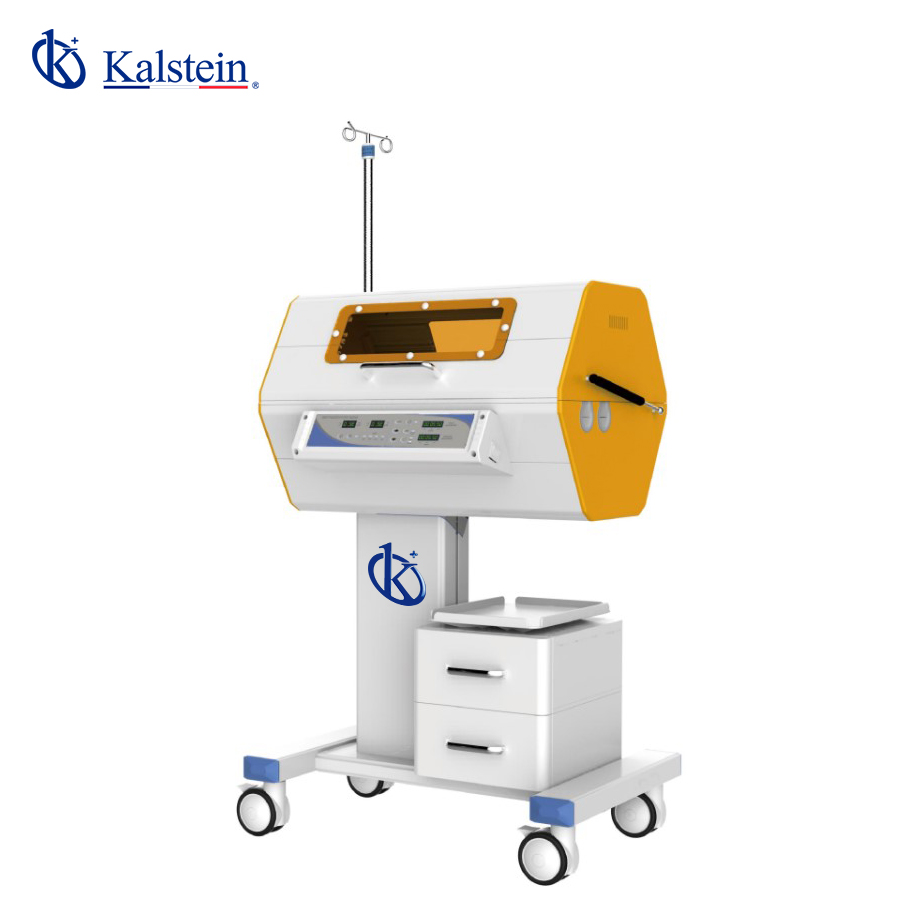Phototherapy, is the treatment used to decrease bilirubin levels in neonates, based on photo degradation resulting in treatments under light UZ to easily depose. The effectiveness of the treatment will depend on the intensity of the light, regulated by filters of 400 and 550 nm, approaching as close as possible to the blue light. It also influences the intensity of the radiation, regulated by controls of light intensity towards the patient, taking into account the distance between the patient and the light.
It is important to have an appropriate radiometer to measure the light levels transmitted by the phototherapy unit, as they may vary according to the combination of the sources of each unit, with the minimum being 18 microwatts/cm2/nanometer at 40cm for the contact units of 19 microwatts/cm2/nanometer and for the pedestal units of LED’s from 40 microwatts/cm2/nanometer to 40 cm.
Likewise, the body area exposed during treatment will determine the effectiveness of phototherapy, taking into account that the area of a fully developed normal baby is about 2100 cm2, and for a 32-week premature baby is about 1300 cm2. Treatment has shown an increase in the elimination of bilirubin produced by the baby, thus reducing the levels of it.
Types of Light Sources to Measure Phototherapy
Thanks to the therapeutic light provided by the phototherapy unit, it allows to improve bilirubin levels, by means of fiber optics that is in direct contact with the patient’s skin. The units are equipped with intensity controls to adjust the irradiation levels.
These phototherapy units have different types of light sources, which use:
- Fluorescent tubes, these types of lights do not emit dangerous levels of radiation, they are white and cold light or blue light. These units have Plexiglas protections to filter out any ultraviolet radiation.
- Tungsten-halogen bulbs, include internal filters to reduce harmful energy that emit light over a wide spectrum (280 to 1,400 nm), consequently emit ultraviolet radiation and near-infrared radiation, which at high levels can damage the eyes and skin.
- Light-emitting diodes (LEDs), this source uses little energy and declares long duration. Blue light emitted is between 450 to 475 nm, does not increase temperature or emit ultraviolet radiation.
Control in the Measurement of Phototherapy
In order to protect the life of patients who receive phototherapy, vital medical care is needed for the maintenance and success of the treatment management process, because appropriate care improves the effectiveness of phototherapy and minimizes complications. Among the care provided by the nursing staff are:
- Effective radiation guaranteed, it is to verify the number of hours of use of the phototherapy units.
- Place the phototherapy as close as possible to the patient (10-30 cm).
- Surround phototherapy with white covers and/or aluminum foil to increase reflective power.
- Do not place objects on phototherapy units.
- Make postural changes (prone and supine decubitus) every 3 hours.
- Place eye protection without exerting too much pressure.
- To avoid risks, the correct patient posture should be placed periodically.
- Keep the patient in proper clothing.
- Monitor body temperature.
- Thorough cleaning of the perianal area.
- Do not apply fatty substances during phototherapy treatment.
Ensure proper intake:
- Promoting breastfeeding: to help the mother in the technique of breastfeeding, to increase the frequency of the takes minimum 8 shots a day.
- Verify that the child takes the prescribed amount in artificial lactation.
- It is not necessary to supplement with water or glucose if the child is not dehydrated.
Strengthen the parent-child bond:
- Support and calm parents, explain what treatment is.
- Favor physical contact.
- Integrate them in the usual care, change of diaper, putting glasses.
- Turn off phototherapy during visits if bilirubin levels are not elevated.
- Provide sunglasses to parents, protective dark glasses if phototherapy cannot be discontinued when they are next to their child.
- Upon discharge, recommend that parents observe whether: the child gets yellow (arms and legs essentially) or stops eating.
- At the end of the phototherapy process, take blood samples to study treatment results.
Phototherapy Units in Kalstein
We at Kalstein offer you the most advanced phototherapy models, designed for all patients who need care for jaundice, we have YR series units, with fluorescent tubes, widely applicable in all health centers. Our line of phototherapy products provides you with the reliability and stability of LED-light intensive phototherapy for your baby patient.
We are manufacturers and have excellent prices with guaranteed advice to make your purchase the right one. We invite you to see our catalog at HERE or better yet, visit us at HERE

